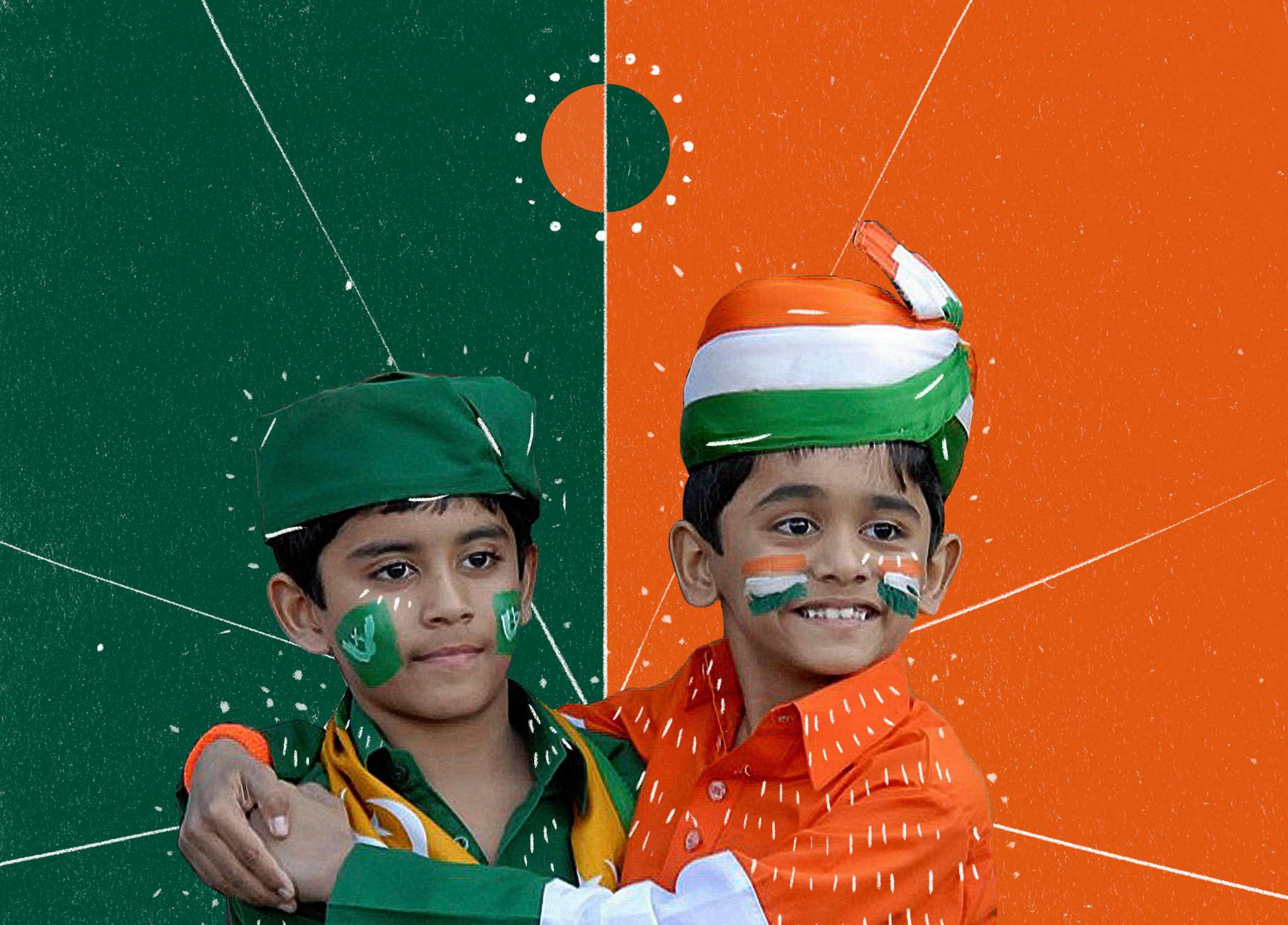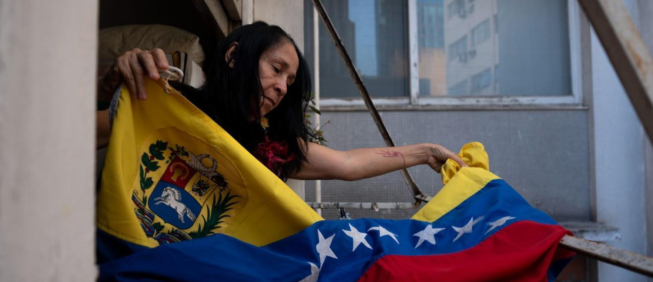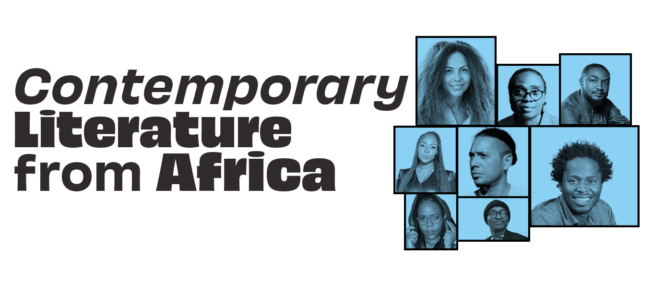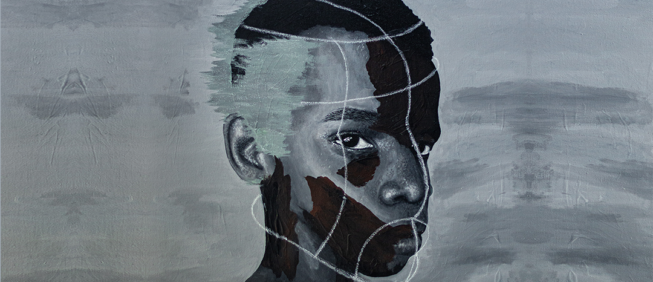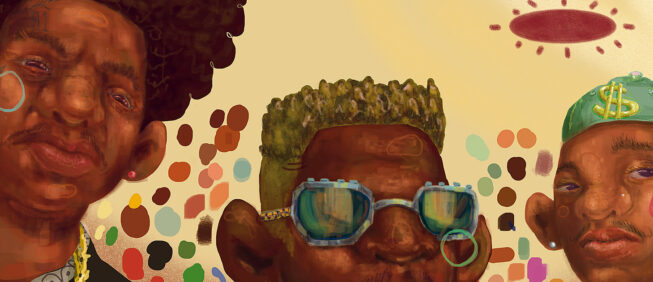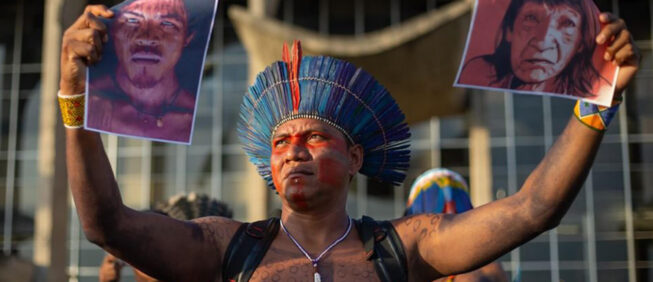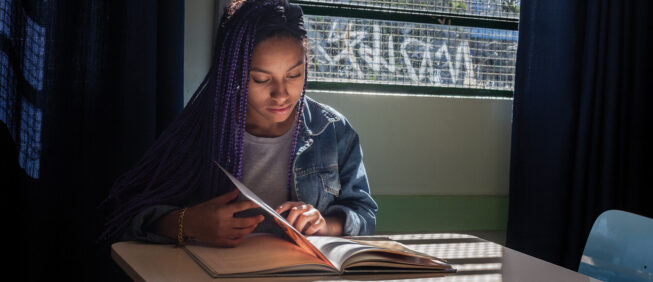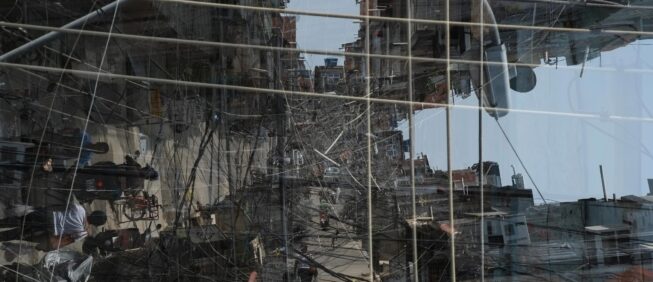Humanizing the other
Combatting stigma in the context of historic conflict
Anam Zakaria
| PAKISTAN | INDIA |
July, 2019
“Now I know that not all Pakistanis are murderers. They don’t want to kill me. I too can think of going to Pakistan.” This was what a 7th grader said after a Skype exchange between her school and me. The one-hour virtual dialogue we engaged in had changed her mind about my country. I wondered what would have happened had we never spoken, had she never had a chance to meet or converse with a Pakistani? Would we remain murderers in her mind? On the other side of the border in Pakistan, when I had handed a 6th grader a postcard from an Indian student – as part of an exchange program I was running for a local NGO, The Citizens Archive of Pakistan – she had started to cry. When I asked her what happened she said that by looking at the postcard, which depicted a Hindu deity, her eyes had sinned. All Hindus, she had heard, burnt in hell. She was terrified that she may have become one of ‘them’ by looking at a photograph of a deity and that she too was now destined for the fire of hell.
Over the past nine years, I have been working with children in India and Pakistan to understand the perceptions they hold of each other and to build dialogue between them. While I have indeed found many forthcoming students, willing and eager to interact with those across the border, others have shared their reluctance or outright refusal to talk to their counterparts across the divide. In Pakistan, the students tell me that they have heard the Indians and Hindus – terms that are used synonymously – killed their ancestors at Partition. They say they want to have nothing to do with them. In India the students say that Pakistanis are terrorists, and what child, after all, would want to engage with a terrorist? The irony is that most Indians and Pakistanis have come to this conclusion without ever really meeting the ‘other.’ A poll by Gallup Pakistan reveals that 76% of Pakistanis have never met an Indian. Visa restrictions and hostile borders mean that most Indians are also unable — and several are unwilling — to cross over. However, this doesn’t mean that the ‘other’ — i.e. those across the border — disappears for people in India and Pakistan. Rather, the ‘other,’ be it Hindu, Sikh or Muslim, Indian or Pakistani, lives on in our textbooks, in our TV debates, in our oral histories, in our public discourse and in our collective imagination. In fact, in many ways today India and Pakistan tend to define themselves in opposition to each other. In popular understanding, India is everything Pakistan is not — “progressive,” economically strong and politically stable – while Pakistan is everything India is not — i.e. Muslim and pure (the work Pak literally translates as purity) as opposed to the ‘kafirs’ or ‘disbelievers’ across the border. Patriotism has taken on new meanings, manifesting in hostility and demonization of the ‘other.’ Since the Partition of 1947 the two countries have fought three wars and have found themselves on the brink of many others.
In the 1940s, as a slow process of decolonization started to take place across the world, India, like many other colonized states, had to address significant questions around governance and politics. One of the most critical issues was the relationship and power balance the Hindu majority and Muslim minority were going to share in “free” India, after almost 200 years of British rule. Muslims, who already faced economic deprivation and marginalization, were concerned about the treatment that would be meted out to them after the British left. While Muhammad Ali Jinnah, the Founding Father of Pakistan, and his political party, the Muslim League initially campaigned for justice for minorities and the emancipation of Muslims in undivided India, eventually the struggle for rights would manifest in the demand for a separate country, Pakistan. Analysts and historians have long argued over whether Jinnah truly wanted a separate nation or whether he was using the demand for Pakistan as a pressure tactic to ensure rights for Muslims in undivided India. As part of his movement, however, he argued that that the Muslims of the sub-continent were a separate nation, belonging to a different civilization than the Hindus. According to eminent Pakistani historian Ayesha Jalal, by using the “Two-Nation Theory” Jinnah hoped that the Muslim League would get a fair share of power at the center. As history would have it though, Muslims were not guaranteed the rights Jinnah had demanded and Partition was announced and hastily executed by the British.
By this time communalism had made significant inroads in India. Despite hundreds of years of co-existence, faultiness existed between the communities, and were only exacerbated and exploited under Britain’s famous divide and rule policy. In a land in which religious identities could be fluid, the British has imposed rigid categories, classifying Muslims, Hindus, Sikhs and other minority religions into neat binaries, ignoring that many of their practices overlapped. These religio-political identities would only be further crystallized at Partition where interreligious violence would kill anywhere between 200,000 and 2 million people, leaving another 14 million people displaced. Harrowing tales of massacre, looting and rape would bloody the cities and villages as the British drew lines splitting the provinces of Punjab and Bengal into two.
One man, who was only 5 years old at Partition, would tell me that even decades later he is unable to shake the images of that time out of his mind. "Abhi bhi mein un kuti hoey aurton, mardon, bachon ke baray mein sochta hoon tou meri ajeeb halat ho jati hai" (Even today when I think abut those chopped-up bodies of men, women and children, I feel ill). His wife would narrate how seven men from her family had been killed during Partition. The women meanwhile would jump into the wells to save their “honour”; death was preferable and deemed more ‘honourable’ than abduction and rape at the hands of men from the ‘other’ community. Countless other such narratives, of trains full of massacred bodies, of neighbours turning on neighbours overnight, of the burning of homes and widespread looting, of sexual violence and killings, are imprinted in the minds of millions of Partition survivors on both sides of the divide.
With such violent narratives deeply embedded in the collective imagination of the Partition generation, it has been difficult for many of them to “move on” or let go of their hostility towards the ‘other.’ My own grandmother had been horrified when I told her I wanted to visit India. “Only snakes live there,” she warned me. She was 22 years old at Partition and had volunteered at Lahore’s largest refugee camp at Walton. Throughout my childhood she would tell me of the blood strewn trains that would roll in, of the battered conditions of refugees, of how many corpses volunteers like her had helped bury. The idea of her granddaughter visiting the “enemy” country was very disquieting. With Pakistan and India at the brink of losing their Partition generation, well-meaning peace activists on both sides have proposed that perhaps the further we move away from Partition, the easier it will be for the youth in both countries to ‘forget’ the bloodshed and foster new relations with each other. After all, they had not suffered as their grandparents had.
Depending on personal family histories, social class, exposure to the ‘other’ in third countries, and other unique dynamics, several Indians and Pakistanis can and have indeed been able to bridge the mistrust and establish relationships. My own interaction with Indians in Canada in my early twenties was transformational, and helped me deconstruct the “enemy” image and humanize the Indians I had been taught to hate. However, for other Indians and Pakistanis, the increasing distance from Partition has only translated in growing hostility. This is because contrary to popular understanding Partition isn’t a static event that one can simply ‘move on’ from. Rather 72 years after the divide of the Indian sub-continent and the birth of Pakistan, Partition remains ongoing, informing Indian and Pakistani politics, media debates, nationalism, external affairs and identity formation.
Pakistani textbooks are rife with anti-India and anti-Hindu sentiments, keeping the divide alive and using the “Two-Nation Theory” to dictate the ideological leanings of future generations. Statements such as “Hindus can never become the true friends of Muslims,” “Hindus started the genocide of Muslims,” and “Hindus harmed Muslims in every possible way” are commonly found in state-sanctioned textbooks in Pakistan. Pakistani academic Tariq Rahman writes that, “Pakistani textbooks cannot mention Hindus without calling them cunning, scheming, deceptive or something equally insulting.”1National Commission for Justice and Peace (NCJP). Education Vs Fanatic Literacy. (Sanjh Publications, March 2013), p.7. Meanwhile in India, the image of Muslims as “savages” or “barbaric” is being popularized through Bollywood and mainstream discourse. Although Indian textbooks have been reformed over the years to eliminate overt hate sentiment, some analysts like Krishna Kumar have argued that Partition is often portrayed as an event in a vacuum, with Muslims depicted as breaking off an integral part of India without any holistic explanations of why the Pakistan movement took birth. The more recent textbook revisions under the incumbent BJP government are feared to instill hyper-nationalism in schoolbooks, glorying the Hindu community. The revised textbooks have already been accused of reinforcing the “Hindu majoritarian worldview” and erasing “minority identities.”
While textbooks are not the only source of learning for students, the hostile state discourses and ‘otherization’ perpetuated through these books have a lasting impact in an environment where people-to-people contact remains limited. Jingoistic debates by news anchors on national TV further add fuel to the fire. With most children never coming across a Pakistani or Indian in their respective countries, texts and words have the power to become the uncontested truth. It is then perhaps no wonder that on my visits to India students have asked me whether I hang out with Hafiz Saeed, whose outfit has been accused of terrorist attacks on Indian soil. It is perhaps no wonder that on a visit to Mumbai a young child of no more than 6-years of age had run away from me when he had heard I was from Pakistan. When I asked him what had happened, he confessed he was scared of Ajmal Kasab, one of the Pakistanis held responsible for the 2008 Mumbai attack that killed over 160 people. Even for such a young child, Pakistani meant fundamentalist, terrorist. That is how he had seen Pakistanis depicted in the media. That is how he imagined them. In Pakistan, one of the students I worked with had told me he had read in his class 5 textbook that Sikhs would slaughter children, butchering them into tiny pieces. When he crossed the border with me for an exchange project, he said he was terrified that Sikhs would be waiting for him holding daggers in their hands. Relief had washed over him when he saw them standing there with garlands and sweets instead.
When I was in my mid-twenties I went back to my grandmother and said to her, “You have told me so many stories about the bloodshed of Partition, of the conditions of refugees, of the bodies you helped bury. But you also used to live in a Hindu dominated area of pre-Partition Lahore and you went to school. Didn’t you have any Hindu or Sikh friends? How come you have never spoken about them?” To my surprise, my question sparked a conversation and revealed information that many in my family had not been privy to. For the first time in twenty-five years of my life, I would hear of my grandmother’s Hindu friends, Rajeshwari and Uma. She would tell me that they had visited her sometime ago, several decades after Partition. They had brought her Indian Saris and she had returned the favour by gifting them traditional Pakistani clothes. Soon I would hear how her father’s Sikh friend kept her younger sister’s nickname and how her other sister was rescued by a Sikh midst the Partition violence. These were stories that had escaped my mother’s generation. I wondered what would have happened if I too had never heard them. I also wondered how many other Partition survivors kept such anecdotes and tales safely guarded in their hearts, taking them to the silence of their graves.
I began to understand that Partition must be viewed on a spectrum where stories of bloodshed and harmony often coexisted. Nation-states only focused on selective histories, emphasizing how the ‘other’ community had perpetrated all violence. For instance, in Pakistan, one only hears of Hindu and Sikh violence against Muslims. For Partition survivors, however, the reality was far more complex and also full of contradictions, as truth often is. While members of one community were killing people, it was often others from the same community that came forward to rescue them. While Muslims were treated as untouchables in some Hindu homes, in others, Hindu religious festivals would be incomplete without participation from their Muslim neighbours and friends, and vice versa. These nuances that had been erased in state-endorsed discourses, find their way in the archiving of personal memories. In recent years civilians in India and Pakistan have initiated several initiatives to record Partition memories from survivors. The Citizens Archive of Pakistan, the 1947 Partition Archive and the Partition Museum are some of these ventures. In an environment of increasing hostility, these oral histories can provide an important way to humanize the ‘other.’ This is particularly so because despite the violence they had witnessed and the bitterness they hold, Partition survivors also remember a time when the ‘other’ wasn’t really the ‘other’ but an integral part of society.
As Indian political psychologist, Ashis Nandy, who has conducted extensive research on Partition, states, “those who had actually faced the violence, those who are direct victims, the first generation of victims, those who have been subject to the violence, those who have seen it first-hand, mostly were those who had lesser prejudice and lesser bitterness about their experience than their own children and their grandchildren because they had lived in communities where the other side was the majority... they have lived with them and they have very warm memories of that experience. Many of them have said that those were the best days of their lives, whereas the children have a packaged view mostly of those violent days and how the family survived… so they carry more bitterness, more hostility.’
Oral histories and personal family stories can then be transformational. One woman I interacted with in Lahore, who was born years after Partition, had told me she never wanted to visit India nor let her children cross over. Her father had lost many family members at Partition in Kapurthala, now in India. When she imagined the country, she could only think of her ancestors’ bloodshed. She refused to give her son permission to go to India as part of an exchange program, fearing that if he crossed over he may never return, meeting the same fate as her other family members. It was, however, her own father, who had suffered and survived the bloodshed who insisted that his grandson must travel to the other side. “He is going to my home,” he said, “nothing will happen to him.” The child who crossed over and interacted with Indians, told me the visit had entirely changed his mind. “Now I know Indians are just like us. I tell everyone that they must visit, that India is nothing like we had imagined.” There is no monster lurking on the other side, no daggers, no killers.
Unfortunately, such exchanges are limited. While periodically, visa restrictions are softened and the governments of India and Pakistan say they are open to people-to-people contact, with so many thorny issues between them, the conditions can sour at any time. Most recently, the two countries have clashed over the killing of 44 troopers from the Indian Central Reserve Police Force, which India alleged Pakistan was responsible for. Airstrikes and a war-like situation quickly unfolded between the nuclear powers. Though tensions have deescalated, such hostilities between the two countries are not new, halting travel and interrupting people-to-people contact cyclically. However, one medium of interaction has thus far been able to sustain itself; the use of technology.
Over the past few years, I have been using Skype to connect school children in India and Pakistan with each other. Students who are reluctant to engage with each other are encouraged to research on the country and ask informative questions so they can learn about the ‘other’ through the ‘other.’ These Skype exchanges can play an instrumental role in enabling Indians and Pakistanis to virtually ‘meet’ each other. For most of them, this is their first interaction and they are bursting with questions for a people they have long imagined but seldom had the chance to speak to. Conversations range from discussing stereotypes of each other to mundane topics such as their favourite sport, TV show and food. After a recent Skype exchange, a student who had initially refused to partake in the conversation because of what she had read about Indians in her textbooks, said to me “They are just like us! They like the same food that I do. When can we talk to them again?”
While certainly there is no quick fix to historical conflicts, and connection does not necessarily equate to peace or love for the ‘other,’ it does humanize those we imagine to be our enemies. Over the past nine years, I have seen dozens of children come together through physical and virtual exchanges, and while the impact varies, none of them leave the room without some subtle shift in their understanding of this ‘other.’ According to the Gallup Pakistan study, 73% of Pakistanis stated that their perspective on Indians changed positively after meeting them. While India and Pakistan are said to share one of the most dangerous borders in the world, this people-to-people contact cuts across the divisive lines to foster a more tolerant future generation. This generation may be the only hope for upholding the fragile peace in the nuclear-armed region.

Anam Zakaria | Pakistan |
AnamZakaria is the author of The Footprints of Partition: Narratives of Four Generations of Pakistanis and Indians (HarperCollins Publishers 2015) and Between the Great Divide: A Journey into Pakistan-administered Kashmir (HarperCollins Publishers 2018).
anamzakaria@gmail.com